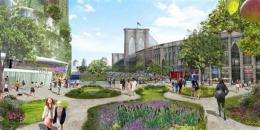NY exhibit imagines utopian, green cities in 2030

(AP) -- Imagine no cars - or fewer, anyway. In New York, a two-mile stretch of the FDR Drive parkway is torn down to open lower Manhattan for parks and plazas, and bicyclists are given their own lane on the Brooklyn Bridge.
An elevated highway in Guangzhou, China, is transformed into a pedestrian promenade, and rooftops are linked by raised walkways and bikeways.
In Jakarta, Indonesia, traditional bike taxis called becaks are re-engineered to be lighter and easier to steer.
The three cities and seven others are featured in an exhibit on environmentally friendly transportation of the future opening Thursday in New York. The exhibit, titled "Our Cities Ourselves," will be at the Center for Architecture in Greenwich Village through Sept. 11 before traveling to the other cities, which include Buenos Aires, Argentina; Budapest, Hungary, and Johannesburg, organizers said.
"We hired 10 architects from cities all over the world to help us imagine what their cities might look like in 2030 if we made the cities more human scale, more environmentally sustainable," said Walter Hook, the executive director of the Institute for Transportation and Development Policy, which organized the exhibit with funding from the San Francisco-based ClimateWorks Foundation.
Hook cradled his bike helmet in one arm as he provided a tour of the exhibit.
"We're essentially trying to send the message that if cities don't move in this direction we're going to be faced with cataclysmic climate change, because in the developing world the use of private automobiles is escalating at double-digit rates," Hook said.
The cities were chosen because Hook and the New York-based ITDP have relationships with them, having helped design bus systems in Jakarta; Mexico City; Ahmedabad, India, and other locales.
The exhibit includes images and 3D models of urban neighborhoods as they are envisioned in 2030 alongside current photos of the same neighborhoods.
In the township of Soweto, in Johannesburg, current photos show low-rise housing and not much else. But the Soweto of 2030 is bustling with markets and public spaces.
"You weren't allowed to open shops, traditionally, under apartheid," Hook said. "So what we've done is we've sort of reimagined it as a kind of new town ... where people could actually work and shop in downtown Soweto."
The model of Guangzhou, also known as Canton, shows a network of rooftop footpaths evoking Dr. Seuss.
"In China, anything's possible," Hook said.
The Utopian vision of lower Manhattan shows pedestrians, bicycles and very few cars. Architect Michael Sorkin, who designed the New York piece of the exhibit, said he thinks it's "completely feasible."
"The streets were laid out by the Dutch in a fundamentally medieval pattern," he said. "They're not made for cars."
In the New York of the 2000s, Mayor Michael Bloomberg has won plaudits from alternative transportation advocates for putting pedestrian plazas in the middle of Times Square, near Broadway theaters, and in Herald Square, where the Macy's flagship department store is located.
Sorkin said his own ideas such as tearing down the lower part of the FDR Drive, which runs along the east side of Manhattan, are equally plausible.
"A year ago nobody thought you could close Broadway," he said. "But suddenly it's closed, and everyone loves it."
"Our Cities Ourselves" travels to Guangzhou after New York. The other cities in the exhibit are Ahmedabad; Budapest; Buenos Aires; Dar es Salaam, Tanzania; Jakarta; Johannesburg; Mexico City and Rio de Janeiro.
More information: http://www.ourcitiesourselves.org/
©2010 The Associated Press. All rights reserved. This material may not be published, broadcast, rewritten or redistributed.

















